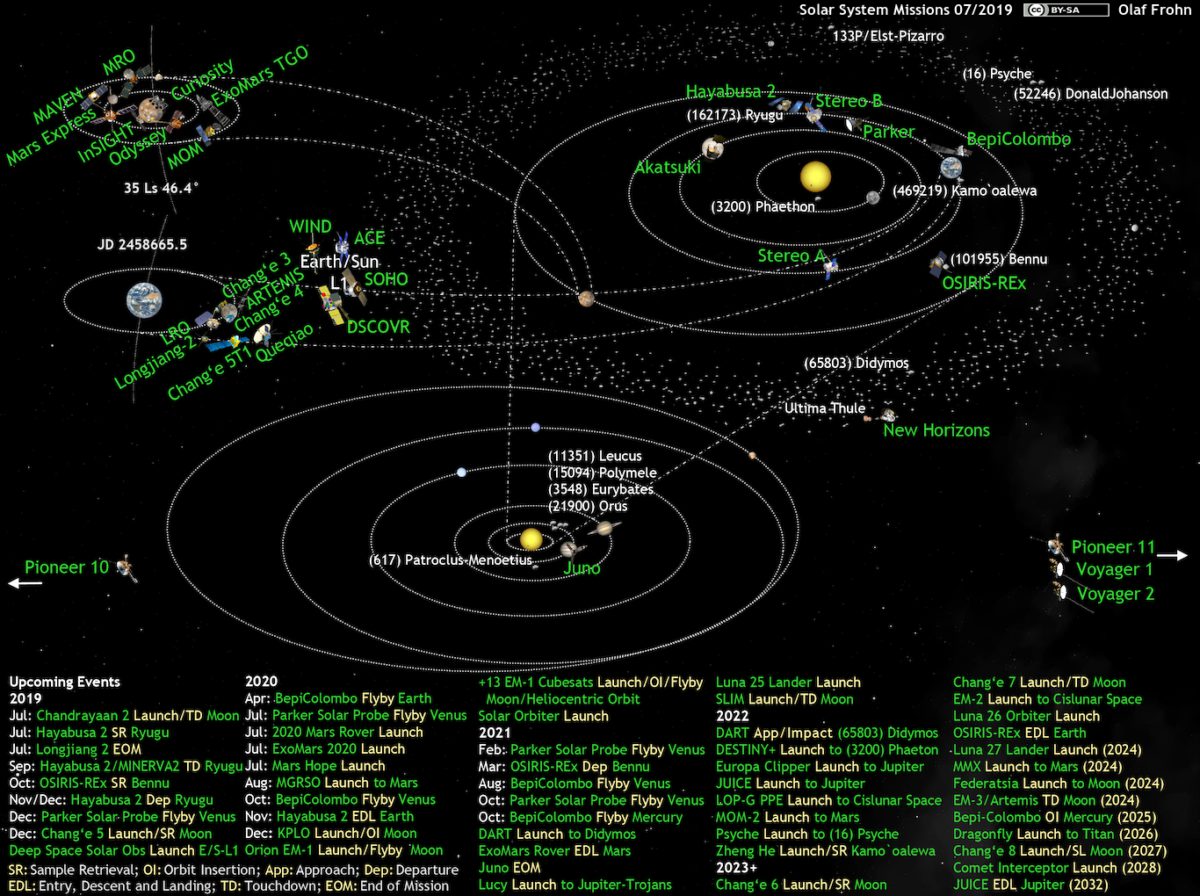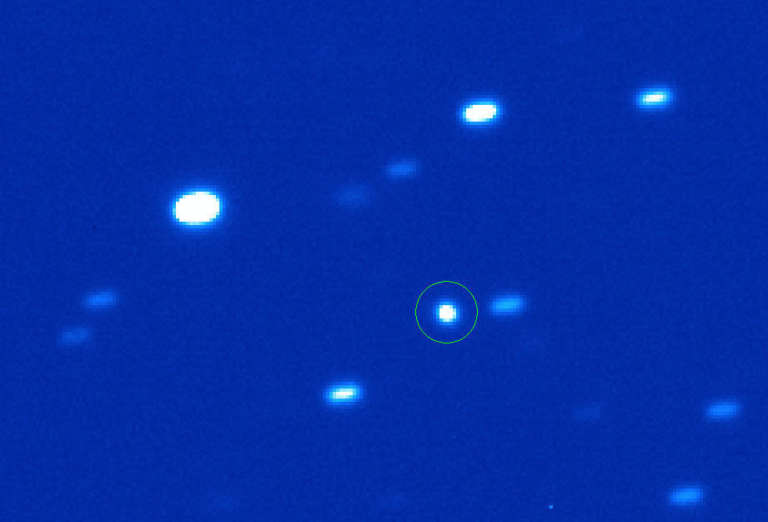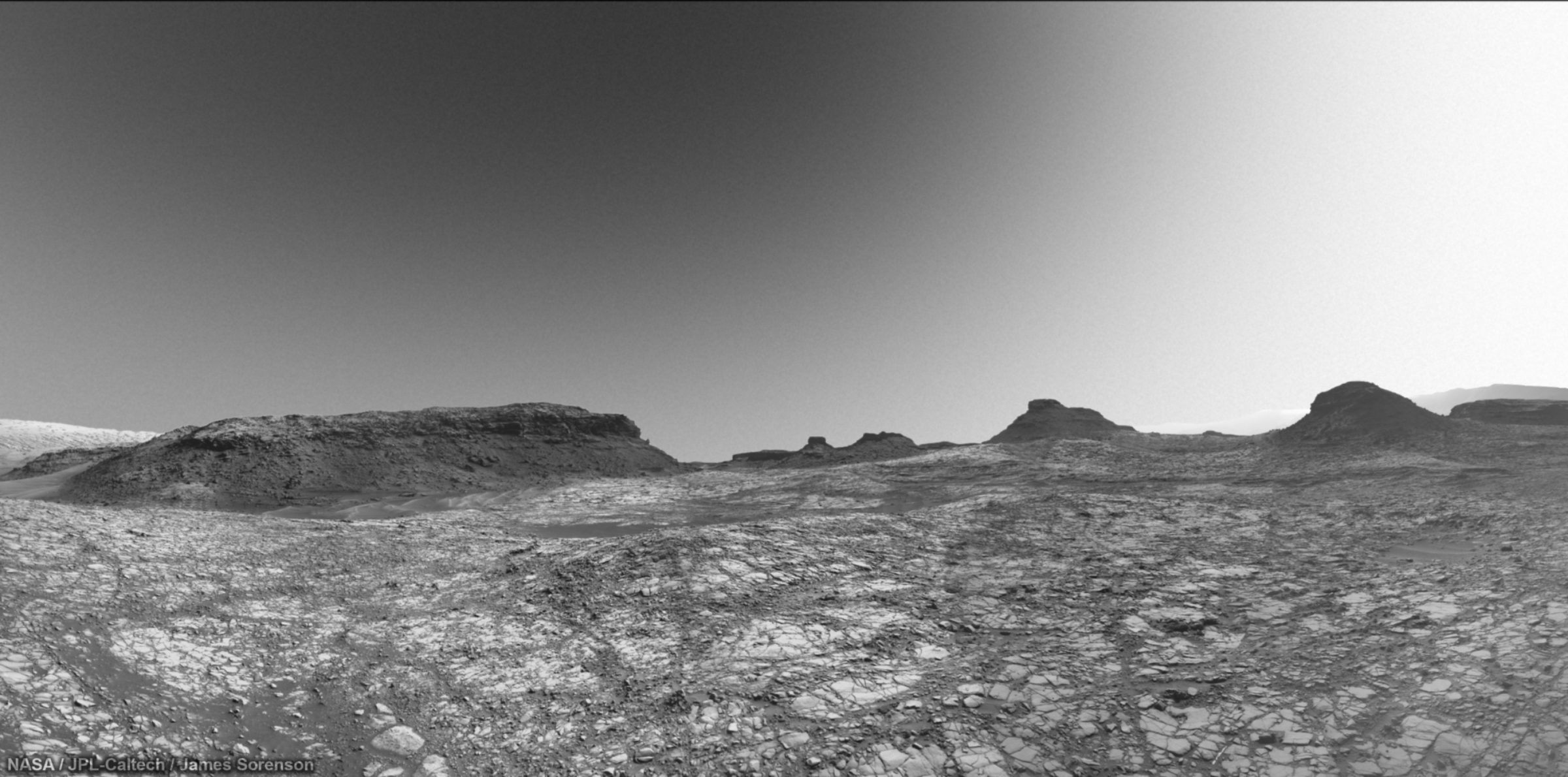Emily Lakdawalla • Jul 29, 2016
What's up in the solar system, August 2016 edition: Juno to get Jupiter close-ups, Rosetta descending, road-tripping rovers
Welcome to your solar system exploration update for the month of August, 2016! The thing I'm most excited about this month: we'll finally see JunoCam's first high-resolution images of Jupiter. We'll also see OSIRIS-REx making progress toward its September 8 launch. Both rovers are road-tripping at Mars, while ExoMars Trace Gas Orbiter has completed a major mid-course correction ahead of its October arrival. Rosetta is at the beginning of the end of its mission, saying farewell to Philae and shifting into lower orbits. New Horizons is getting very close to the end of transmitting all its Pluto data, plus a new pile of data on distant Kuiper belt objects. Read on for more detailed updates on these and all the other active missions exploring our solar system. But first, here's Olaf Frohn's chart of active space missions.

Earth Launches and Landings (contributed by Jason Davis)
The SpaceX Dragon capsule that arrived at the International Space Station on July 20 will remain berthed to the orbital laboratory all month, departing on August 29. In mid-August, astronauts Jeff Williams and Kate Rubins will suit up for a spacewalk to install a new docking adapter currently stored in Dragon's unpressurized trunk. As early as August 22, Orbital ATK plans to send its re-engineered Antares rocket on a return-to-flight mission, blasting a Cygnus cargo craft on its way to the ISS.
In other U.S. launch news, SpaceX's next mission is the launch of JCSAT-16, a Japanese communications satellite, though a date has yet to be specified. Spaceflight Now reports the next United Launch Alliance Delta IV flight may occur August 19. That mission will carry two satellites for the Air Force's Geosynchronous Space Situational Awareness Program, which can produce "eye-watering" views of other objects in geosynchronous orbit, according to Space News.
Internationally, an Ariane 5 will launch two communications satellites from French Guiana on August 24. Russianspaceweb.com says a Russian Proton rocket is scheduled for liftoff on August 29, carrying an American communications satellite. Finally, delayed missions from last month include a Chinese quantum communications technology demonstration satellite, and an Indian Earth observation spacecraft. Both missions may go for retries in August.
Inner Solar System
As of July 19, Akatsuki has spent a year in orbit at Venus -- a Venus year in orbit, that is (243 Earth days). JAXA posted a brief update on the mission with a pile of photos from its different cameras. Some of the photos look like ones I've seen before, but this one -- taken with a camera that sees in a near-infrared wavelength of 2.26 microns -- is really unusual.

Earth's Neighborhood
This month, new moon is on August 2 and full moon is on August 18. I don't have much news from Lunar Reconnaissance Orbiter, but it's actively surveying the Moon. It's always worth checking the LROC website for the latest images. A recent update on Chang'e 3 states that the Chinese lander has just gone to sleep for the lunar night, its 33rd. As usual, I'm not sure about the status of Chang'e 5 T1.
I got an update on the pair of ARTEMIS spacecraft from project scientist David Sibeck: "Although the ARTEMIS instruments were not designed to measure molecular ions, their observations have been used to infer the presence of heavy molecules (N2+, NO+, and O2+) from Earth at lunar distances....Simulation work shows that they drifted out of the Earth’s radiation belts and got entrained in the flow of solar wind plasma that had entered the Earth’s outermost magnetosphere, thence were swept antisunward to the Moon. Apparently they are a regular feature at, and can influence the lunar environment." I'll have a bit more about this in a future blog post. In the meantime, enjoy this artwork of ARTEMIS near the lunar wake.
This is the first appearance in a "What's Up" post of the OSIRIS-REx mission, due to launch on September 8. (It's still in "Earth's Neighborhood" and will be for a little while after its launch, after which I'll shift it to "Near-Earth Asteroids.") The spacecraft is in Florida and undergoing final assembly and testing; there are several crucial reviews taking place with much to make sure that the spacecraft is really ready to launch safely.
The @OSIRISREx rocket fairing has arrived @NASAKennedy - one step closer to launch #ToBennuAndBack ! pic.twitter.com/M2pNhK9XZt
— Dante Lauretta (@DSLauretta) July 27, 2016
Near-Earth Asteroids
Hayabusa2 is now 78 million kilometers from Earth and 67 million kilometers from Ryugu. The Ryugu observation campaign is proceeding, and one of the most recent results is the image below, taken from the Very Large Telescope. It may not look like much, but it will provide data of high value for planning Hayabusa2's mission: the rotation period and pole orientation. Follow Hayabusa2's journey with this interactive visualization tool.

On the Way to Mars
ExoMars Trace Gas Orbiter performed its largest mid-course trajectory correction maneuver successfully yesterday, burning its main engine for 52 minutes. Remaining trajectory correction opportunities come on August 11, September 19, and October 14. It will release Schiaparelli on October 16, divert slightly from the lander release trajectory on October 17, and then enter orbit on October 19. Schiaparelli will land on the same day. Here's an overview of what to expect on arrival day.
Mars
Mars passed through the northern autumnal equinox on July 4, so the north pole is entering winter darkness and the days are getting longer and warmer at the southern hemisphere landing sites of the two Mars rovers.
I don't have much news on Mars Odyssey or Mars Express. It's always worth looking at the THEMIS and VMC images. I don't have any updates on the Mars Orbiter Mission since June.
Mars Reconnaissance Orbiter results have featured in numerous science stories in the last month, including ones about the role of water in Martian dark streaks; the role of dust in Mars' weather; and the lack of water in Martian gullies (note that slope streaks and gullies are both distinct from Martian recurring slope lineae). The most recent MARCI weather report talks about "extensive dust-lifting over the northern plains" but "relatively clear" skies for the rovers. My favorite HiRISE image release from this month is this one of a "glorious glacier". There's also a beautiful image of a new recent impact site.
For a detailed update on MAVEN, which will complete one Mars year of operations in September, read Bruce Jakosky's guest blog posted this week. The next deep-dip campaign is planned to begin August 3.
Both rovers are road-tripping right now. Opportunity has now driven more than 43 kilometers, most recently moving north and down the eastern face of the Endeavour crater rim, still within the Marathon Valley. The power situation continues to be very good, with the solar panels generating around 630 watt-hours daily, and atmospheric opacity hovering around 0.6.
On the other side of Mars, it's sol 1415 for Curiosity and the rover has been driving steadily south since sol 1369. Curiosity has traveled more than 500 meters south of the last drill site, Oudam. More importantly, over that distance, Curiosity has traveled upward through the rock record by about 25 meters of elevation. That means it's time to drill again, to keep up a systematic survey of the mineralogy of the Murray formation as the rover travels up the stratigraphic section, so look for a new drill site in the next week or two. After that, it still has to drive another 500 meters or so to get beyond the first line of dunes, then another kilometer to cross an interdune region of bedrock, then another kilometer-plus of dune-threading before it will arrive at the next change in bedrock type. Throughout the driving, the views have been awesome:

Beyond Mars
This month, Rosetta will shift into a series of elliptical orbits that will bring it progressively closer to the comet, in preparation for the mission's end on September 30. As mentioned on this blog earlier, the spacecraft is shutting down nonessential systems because of declining solar power; one of those nonessential systems was the package that had been used to communicate with the silent Philae lander. Last month the Rosetta blog hosted an interesting article about the origin of comets, based on research performed with Rosetta data. The latest NavCam release covers images taken through June 28. As always, check here for the latest NavCam image releases and here for the OSIRIS image of the day.
With its prime mission over and the decision made for Dawn to remain at Ceres, we're starting to see a higher rate of scientific results coming out of the mission. Two stories came out last month, about permanently shadowed regions at Ceres, and a curious lack of large craters. Regular readers will recognize the latter story, which I covered when it was presented at the Lunar and Planetary Science Conference in March. As always, check the Photojournal for the latest images!
As far as I know, Juno is doing fine; it will reach the apojove on July 31, beginning "orbit 1." It will spend almost all of August approaching Jupiter, speeding up all the way, until it executes its first close encounter with the planet with all its instruments firing at Perijove 1 on August 27. Once Juno returns the data to Earth, we should see the closest-ever images of Jupiter's clouds, and stunning pole-on views of the planet. I can't wait. JunoCam should have been shooting images continuously since July 9. After that, we're headed toward conjunction on September 26, a period when Juno will not be permitted to do much science or other activity. The science mission begins on November 9. Don't forget to visit the JunoCam website to discuss features visible in amateur astronomers' Jupiter images.
Cassini will reach apoapsis on July 30, beginning its Rev 239. There will be a targeted flyby of Titan on August 10, which will be used for gravity science, an opportunity to detect Titan's subsurface ocean. The 1600-kilometer flyby will raise Cassini's orbit inclination even more, to a very high 53.5 degrees. These high-inclination orbits are designed for studies of the rings; Cassini will be looking at "propellers" in the rings, and also observing several bright stars pass behind the rings. It will shoot a color portrait of the lit rings on August 6, and search for meteor impacts onto the C ring(!) on August 9. As always, check the raw images page for the latest views from Cassini's cameras.
I have a couple of updates on New Horizons. According to Kim Ennico they currently expect to complete the process of returning all the data from the Pluto encounter in late October or early November, but of course that depends on the schedule with the Deep Space Network and things could change. Meanwhile, they've had "a busy July" acquiring new data, according to John Spencer. He told me they've been "doing post-Pluto calibration observations of stars and so on during a brief 3-axis period, but also looking at KBOs Quaoar, 1994 JR1, Ixion, and 2002 MS4, plus Centaurs 2010 JJ124 and Chiron to get phase curves (though we don't expect to actually detect the Centaurs unless they have strongly forward-scattering rings, which is what the observations are designed to test)." The spacecraft has to be in 3-axis stabilization mode to be able to do these kinds of observations. The spacecraft has now returned to spin-stabilized mode, in which they can't point cameras but they can double their downlink rates. They'll remain spin-stabilized until January 2017, when they'll observe more Kuiper belt objects. For more on New Horizons, check out the latest team blog posts: one by Fran Bagenal on her 26 years of involvement in a Pluto mission; one by Anne Verbiscer on studying the opposition effect; and one by Cathy Olkin and Eddie Weigle on commanding spacecraft instruments.
Finally, the Voyagers are still going, going, going. Voyager 1 is at 135.7 AU from the Sun, and Voyager 2 is at 111.8 AU.
Let’s Go Beyond The Horizon
Every success in space exploration is the result of the community of space enthusiasts, like you, who believe it is important. You can help usher in the next great era of space exploration with your gift today.
Donate Today

 Explore Worlds
Explore Worlds Find Life
Find Life Defend Earth
Defend Earth


